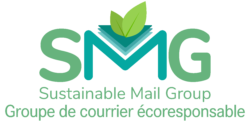Plastic
“The Sustainable Mail Group advocates for the immediate reduction and eventual elimination of plastics in the mail stream. This includes the elimination of so-called “bio plastics” which require specific catalysts to completely degrade in the environment.” To learn why, read on….
Plastic
Overview
In the mail ecosystem, plastic products are used for two main reasons:
- Plastic materials provide a low cost and simple solution for safe and protective packaging.
- Transparent plastic enhances the effectiveness of mailers’ advertising spend.
While plastics deliver important benefits to mailers, the use of plastic material is becoming recognized as a problem to be address by all industries. How big is the problem? Canada produces roughly 3.3 million tonnes of plastic each year. About 2.8 million tonnes make their way to landfills, the equivalent of 24 CN towers. Much of this waste material migrates from landfills into waterways and eventually into the oceans. The “Great Pacific Garbage Patch” is reported to cover an area twice the size of Texas.
Pressure to reduce and eventually eliminate the use of plastics in packaging materials is growing. Consumers are becoming more sensitive to the presence of plastics in packaging and are making their voices heard. Governments are responding and have begun to mandate the elimination of unnecessary plastics.
The plastic objective
The Sustainable Mail Group advocates for the immediate reduction and eventual elimination of plastics in the mail stream. This includes the elimination of so-called “bio plastics” which require specific catalysts to completely degrade in the environment.
SMG recommends cutting the use of plastic alternatives by 50% by 2024 at the latest. The materials to eliminate include oxo poly, bio poly and other “degradable” plastic alternatives which are being targeted by regulators. LDPE (low density polyethylene) products, including polybags and wrap, are also targeted for elimination by the government, possibly as early as 2025.
First steps
- Join the discussion about developing effective paper wrap alternatives to polybags. Now is the time to begin testing new materials and techniques.
- Ensure that if plastics are used, they can be easily separated from the rest of the materials for recycling.
- Explore the idea of setting up a recapture strategy that can eventually turn to profit generation.
- Consider sourcing non-virgin plastic whenever possible. Certified post-consumer resin plastic (PCRP) is preferred.
